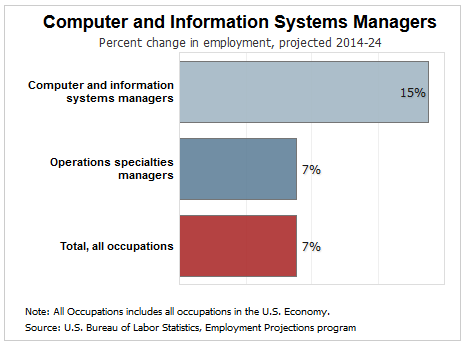
 The job outlook for information security (IS) is looking better than ever. According to the Bureau of Labor Statistics, nearly 350,000 IS managers were employed throughout the U.S. in 2014, collectively averaging $61.37 an hour. With companies scrambling to fill IS departments from the CISO (Chief Information Security Officer) at the top to the techs at the bottom, you may be wondering why the surge is going on now and how you can ride the wave yourself into a career as a CISO.
The job outlook for information security (IS) is looking better than ever. According to the Bureau of Labor Statistics, nearly 350,000 IS managers were employed throughout the U.S. in 2014, collectively averaging $61.37 an hour. With companies scrambling to fill IS departments from the CISO (Chief Information Security Officer) at the top to the techs at the bottom, you may be wondering why the surge is going on now and how you can ride the wave yourself into a career as a CISO.
The Evolution of the Threat & How Businesses Understand It
Before computer networking expanded beyond the office building's walls, information security was more of a problem related to physical security and in-house access control. Even though older technology was not immune to abuse, telephone hacking (phreaking) was limited in potential to harming telecom company profits (namely that of then monolithic monopoly holder, AT&T), and breaking into a company's computer network could still be less beneficial than sneaking into the file room. This all changed as the pace of IT development exponentially increased the capabilities of computers and the spread of the networks to which they connect.
The Digital Revolution
While the birth of the Internet took place inside the computers of military and university researchers, it wouldn't take long for the ability to transfer data at rates and volumes never seen before to spark innovation in the corporate world. At the same time as computers and devices like smartphones began to implant themselves in the daily lives of people and businesses around the world, the value of gaining control of said devices and the communications sent between them. Governments and trade organizations logged onto the network, and the power to influence them expanded to anywhere in the world where one can plug into the system.
An Apparent Problem - For Someone Else
Glancing through news reports on hacking incidents dating back to the early '80s shows a steady growth in the number of attacks. The annual Verizon reports paint a dismal picture of a war in which the enemy always seems to be one step ahead despite the best efforts of the defenders. Despite the value of the data contained in their systems and the exponentially increasing number and effectiveness of digital heists, it has still been unlikely for companies to create a dedicated IS manager position. The national general store, Target, would only hire a CISO half a year after a data breach that left millions of customer's personal and financial data open to abuse. Even the White House only started looking for someone to fill their newly created CISO position in February of 2016. Coincidentally, this comes three months after the discovery of a robust database of voting data on nearly 200 million U.S. citizens.
The Dawning of the Age of IS Enlightenment
The realization that companies of every size need a comprehensive IS plan is slowly sinking in, though, and demand for cybersecurity staff ranging from the CISO to the frontline techs has created a massive cache of open positions that represents the gaping hole in the IT defenses of the business world.
Modern CISOs: Who Are They?
The typical responsibilities of a CISO are developing, implementing, and testing IS policies that merge with the company's business plans and coordinating these goals with the board, the IS team, other company departments, partners, and clients.
A Chief Information Security Officer is someone who can bridge the gap between how technological security needs to function and the inner workings of a functional business. They need to know how to navigate the complications of a digital battlefield that can change in the blink of an eye while complying (and often improving upon) the regulations set forth by watchdog organizations. The capabilities of technology and how to direct the security practices of everyone from customers to associates to IT staff requires a CISO who can create actionable plans and relate them to everyone in the company, regardless of their level of familiarity with computers. More than anything, the CISO is the general of the forces protecting the digital trade routes of their company and allies.
You can look to examples like Steve Katz, popularly described as the 'first' CISO. He credits much of his success to finding skilled security experts to fill department roles, creating a healthy collection of antibodies for the computer systems of financial fixtures like JPMorgan and CitiBank.
How Can You Become a CISO? Start Your Path Here.
Even with the open field that's ripe for newcomers, you won't make it to CISO without the right training, experience, and knowledge. Open up the world of IS by pursuing a Master of Science in Cybersecurity degree from ECPI. After learning how to command and protect a computer system, you can enlist with an IS department and move your way up from a team member to the CISO position. It could be the Best Decision You Ever Make!
ECPI University was the best decision i ever made...
— A$AP Dawsonâï¸ (@Itz_Weezy_D) December 15, 2015
DISCLAIMER – ECPI University makes no claim, warranty, or guarantee as to actual employability or earning potential to current, past or future students or graduates of any educational program we offer. The ECPI University website is published for informational purposes only. Every effort is made to ensure the accuracy of information contained on the ECPI.edu domain; however, no warranty of accuracy is made. No contractual rights, either expressed or implied, are created by its content.
Gainful Employment Information – Cybersecurity - Master’s
For more information about ECPI University or any of our programs click here: http://www.ecpi.edu/ or http://ow.ly/Ca1ya.


